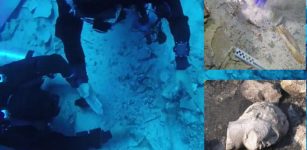Intriguing Collection Of Petroglyphs And Dinosaur Footprints Found At The Serrote do Letreiro Site, Brazil
Jan Bartek - AncientPages.com - The “Serrote do Letreiro” Site, translated as “Signpost Hill,” located in the Sousa municipality, Paraíba State, Brazil, is of great paleontological and archaeological importance.
The site consists of three massive rock formations, collectively spanning an impressive area of over 15,000 square meters. While investigating the Serrote do Letreiro Site scientists found an intriguing collection of petroglyphs next to footprints of footprints of theropod, sauropod, and ornithopod dinosaurs.
Location of the “Serrote do Letreiro” Site and central area of the first and northernmost outcrop, with a high concentration of footprints and petroglyphs. (1) Outcrop one, also referred to as Northermost outcrop; (2) Outcrop two, also referred to as middle/central outcrop; (3) Outcrop three, also referred to as Southernmost outcrop. Footprints in highlight and petroglyphs circled by dashed lines. Coordinates are given in the WGS 84 datum. Satellite photography from Google Earth version 7.3 © Google, Airbus, Maxar Technologies. Map generated with Adobe Illustrator 2019.
The scientists write in their study, published in Nature, that "the petroglyphs, mainly characterized by circular motifs, maintain a striking resemblance to other petroglyphs found in the states of Paraíba and Rio Grande do Norte." A small number of the engravings comprise rectangular grid structures, and others resemble stars.
Scientists have previously focused mostly on the site's palaeontological aspects and paid less attention to the petroglyphs. Giuseppe Leonardi, who began research in the area in 1975, mentioned the existence of petroglyphs but referred to them only as "Cariri Indian carvings."
Although there have been some brief references, a thorough analysis of this collection of rock art expressions has not yet been conducted. Additionally, studies have not considered the correlation between the footprints and the petroglyphs.
Similar but not exactly the same connections between fossils and rock art have been observed in various locations. For example, in Australia, Herbert Basedow interpreted petroglyphs as human-made replicas of dinosaur footprints. In Poland, a dinosaur footprint was discovered at a site that may have been used for occult gatherings. In Utah, USA, there are also sites where petroglyphs and fossilized footprints coexist to some degree; these include Poison Spider Dinosaur Tracks, Parowan Gap, and Zion National Park. However, none of these examples show as strong a relationship between the petroglyphs and the footprints as seen at Serrote do Letreiro. Here it is clear that the creators recognized the footprints and deliberately created their artwork around them - forming a symbolic link between human artistic expression and fossil evidence.
The Serrote do Letreiro petroglyphs "are characterized by their deferred recognition nature. They resemble what is now interpreted as geometric forms, but their meaning and whether they were meant to constitute representational or figurative icons remains unknown," the study informs.
"Despite the profusion of identified petroglyphs, no overlap was observed between these inscriptions and the fossilized footprints. In none of the cases was it found that the creation of a petroglyph resulted in damage to the existing footprints, suggesting thoughtfulness by the makers. In some cases, there is an extreme proximity between petroglyphs and footprints, with some occurring immediately adjacent to the fossilized tracks.
A remarkable assemblage of petroglyphs and dinosaur footprints in Northeast Brazil. Credit: Scientific Reports
The researchers write in the study that this only highlights and establishes a more profound relationship between the archaeological and paleontological records.
The study also informs it is important to note that the differences seen in execution methods and stylistic features among the petroglyphs found at Serrote do Letreiro should not be viewed as proof of separate social authorship, meaning different human cultures. Instead, scientists propose that these variations are more accurately perceived as expressions of individual distinctions among authors from the same social group. Despite sharing a unified graphic or visual identity, these individuals convey their unique personal styles.
Determining the age of these petroglyphs presents a substantial challenge, similar to the ifficulty encountered at other locations within this territory. This is primarily due to the limited attempts made so far in dating sites within this region.
"Human burials of approximately 10,000 years BP were found at Mirador de Parelhas and Pedra do Alexandre, inside what the authors consider the sphere of occupation of the population that crafted the archaeological record found at Serrote do Letreiro and other sites. In Pedra do Alexandre specifically, twenty-eight burials have been dated using radiocarbon, spanning a period from 9400 to 2620 years BP," the scientists write.
" Further research utilizing new methods of direct dating of petroglyphs, such as X-ray fluorescence spectrometry16, will certainly shed light on the chronology issue, the researchers write.
See also: More Archaeology News
The scientists also add that the hypothesis that the makers recognized the footprints as such persists, even considering that the contemporary understanding of fossils and their association with dinosaurs was likely unknown to the people who first encountered these footprints. It is plausible to argue that, despite the absence of knowledge regarding dinosaurs as we understand them today, the footprints were most likely identified as such due to their formal similarity to rhea footprints, the largest bird in Brazil, modern theropod dinosaurs, which currently inhabit the Paraíba region.
This is supported by the fact that in the same context of the Dinosaur Valley (Sousa, Paraíba), the most renowned fossil trackway is popularly known as the "Rhea's Trail," even though the current population knows of the existence and morphology of dinosaurs.
The study was published in Nature
Written by Jan Bartek - AncientPages.com Staff Writer






















